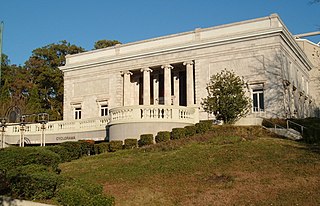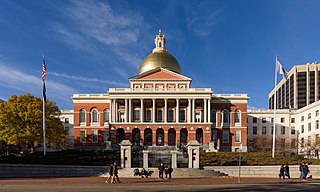
The Isabella Stewart Gardner Museum is an art museum in Boston, Massachusetts, which houses significant examples of European, Asian, and American art. Its collection includes paintings, sculpture, tapestries, and decorative arts. It was founded by Isabella Stewart Gardner, whose will called for her art collection to be permanently exhibited "for the education and enjoyment of the public forever".
A cyclorama is a panoramic image on the inside of a cylindrical platform, designed to give viewers standing in the middle of the cylinder a 360° view, and also a building designed to show a panoramic image. The intended effect is to make viewers, surrounded by the panoramic image, feel as if they were standing in the midst of the place depicted in the image.

The Atlanta Cyclorama and Civil War Museum was a Civil War museum located in Atlanta, Georgia. Its most noted attraction was the Atlanta Cyclorama, a cylindrical panoramic painting of the Battle of Atlanta. As of December 2021, the Cyclorama is located at the Atlanta History Center, while the building is now Zoo Atlanta's Savanna Hall.

The Massachusetts State House, also known as the Massachusetts Statehouse or the New State House, is the state capitol and seat of government for the Commonwealth of Massachusetts, located in the Beacon Hill neighborhood of Boston. The building houses the Massachusetts General Court and the offices of the Governor of Massachusetts. The building, designed by architect Charles Bulfinch, was completed in January 1798 at a cost of $133,333, and has repeatedly been enlarged since. It is one of the oldest state capitols in current use. It is considered a masterpiece of Federal architecture and among Bulfinch's finest works, and was designated a National Historic Landmark for its architectural significance.
The Battle of Gettysburg, also known as the Gettysburg Cyclorama, is a cyclorama painting by the French artist Paul Philippoteaux depicting Pickett's Charge, the climactic Confederate attack on the Union forces during the Battle of Gettysburg on July 3, 1863.

Charles Amos Cummings was a nineteenth-century American architect and architectural historian who worked primarily in the Venetian Gothic style. Cummings followed the precepts of British cultural theorist and architectural critic John Ruskin (1819–1900). Cummings help to found The Boston Society of Architects in 1867.

Wilson Eyre, Jr. was an American architect, teacher and writer who practiced in the Philadelphia area. He is known for his deliberately informal and welcoming country houses, and for being an innovator in the Shingle Style.
The Boston Center for the Arts (BCA) is a 501(c) nonprofit visual and performing arts complex in the South End neighborhood of Boston, Massachusetts. The BCA houses several performance and rehearsal spaces, restaurants, a gallery, the headquarters of the Boston Ballet, the Community Music Center of Boston and several other arts organizations. The BCA also serves as home to four Resident Theater Companies and a number of artists. The BCA's main building, the Cyclorama, is on the National Register of Historic Places. Boston Ballet's headquarters was designed in 1991 by architect Graham Gund.

The Landmark Center or 401 Park Building in Boston, Massachusetts is a commercial center situated in a limestone and brick art deco building built in 1929 for Sears, Roebuck and Company. It features a 200-foot-tall (61 m) tower and, as Sears Roebuck and Company Mail Order Store, it is listed on the National Register of Historic Places and designated as a Boston Landmark in 1989.

The Cyclorama Building at Gettysburg was a historic modernist concrete and glass Mission 66 building dedicated November 19, 1962 by the National Park Service (NPS) to serve as a Gettysburg Battlefield visitor center, to exhibit the 1883 Paul Philippoteaux Battle of Gettysburg cyclorama and other artifacts, and to provide an observation deck. The building was demolished in 2013.

Motor Square Garden, also known as East Liberty Market, is a building in Pittsburgh, Pennsylvania, USA, that is listed on the National Register of Historic Places.

Paul Dominique Philippoteaux was a French artist. He is best known for a cyclorama illustrating the Battle of Gettysburg.

The St. Johnsbury Athenaeum, in St. Johnsbury, Vermont, is a combined library and art gallery. The building in which it is housed is architecturally and historically significant because of its construction. The Athenaeum is also noted for the American landscape paintings and books in its collection and its having been funded by Horace Fairbanks, manufacturer of the world's first platform scale. The art collection contains a number of Hudson River School paintings. This building retains a strong Victorian flavor of the 19th century.

The Boston Flower Exchange is a wholesale flower market located in Boston, Massachusetts. Founded as a marketplace that local growers could rent cooperatively to sell their products in a space more suited to their needs than Boston's historic Haymarket open-air marketplace, it has been the focal point of the floral trade of New England for over a hundred years. Although originally a local growers' wholesale market, the Flower Exchange now features flowers and foliage from dozens of countries and has expanded to carry potted plants, glassware, pottery and other floral supplies. The Flower Exchange is not open to the public and is limited to members of the trade only.

The Colonial Beacon Gas Station was a historic gas station at 474 Main Street in Stoneham, Massachusetts. It was built c. 1922 by the Beacon Oil Company to be a flagship station in their Colonial chain of filling stations. The concrete and stucco building was designed by the Boston firm of Coolidge & Carlson. It had two main sections: an octagonal section that once served as a drive-through filling area, and a rectangular service area to its left. Corinthian columns originally supported the octagonal section; these were later covered over or replaced. The octagonal section was topped by a round dome, at whose apex was a small pillared section that was once topped by a grillwork globe that housed a light. This light, when illuminated, became the beacon which gave the station its name. The service area and pumping bay had a band of starburst panels that ran along the top of the flat roofed service area and around the base of the pumping area dome. The structure was one of about 10 Colonial Oil stations built with a golden dome to resemble the Massachusetts State House on Beacon Hill.

The Gettysburg Museum and Visitor Center is a Gettysburg National Military Park facility, with a museum about the American Civil War, the 1884 Gettysburg Cyclorama, and the tour center for licensed Battlefield Guides and for buses to see the Gettysburg Battlefield and Eisenhower National Historic Site.

Fuller & Delano was an architectural firm in Worcester, Massachusetts, active from 1878 until 1942. It originally consisted of architects James E. Fuller and Ward P. Delano. The firm designed more than 20 buildings that were later listed on the U.S. National Register of Historic Places.

John A. Fox (1835–1920) was an American architect. Fox practiced in Boston for fifty years and is best remembered for his works in the Stick Style.

Holman K. Wheeler was a prolific Massachusetts architect. Wheeler is responsible for designing more than 400 structures in the city of Lynn alone, including the iconic High Rock Tower which is featured prominently on the Lynn city seal. While practicing in Lynn and Boston over a career spanning at least 35 years Wheeler designed structures throughout the Essex County area, including Haverhill, Marblehead, Newburyport, Salem, Swampscott, and Lynn. Wheeler is responsible for a total of five Lynn structures listed on the National Register of Historic Places, more than any other person or firm.

James T. Kelley (1855–1929) was an American architect practicing in Boston, Massachusetts.




















